Over 10 years in the making, a fleet of warring “aero cabs” are preparing for landing. Let the dogfight begin.
Words by DANNY FORTSON
Illustration by SOÑA LEE
It started 13 years ago in a backyard barn in the mountains above Santa Cruz. Today, Joby Aviation, the brainchild of founder and CEO JoeBen Bevirt valued at over $3 billion, is racing to develop the world’s first air taxi—and launch an era that promises to free commuters from gridlock via quiet, emissions-free air transport for the masses.
An estimated 200-plus companies around the world, large and small, have raised billions of dollars to develop wildly different prototypes of so-called eVTOLs (electric vertical takeoff and landing vehicles), drafting on huge advances in electric motors and battery technology. This period of invention has been likened to a modern Wright Brothers era, replete with a battle full of intrigue, infighting, harebrained ideas and bitter lawsuits. Leading the pack is Joby.
The company, still based in Santa Cruz, has raised more than $1.8 billion in funding—an amount reportedly far greater than any of its competitors. Its five-seat eVTOL model is furthest along the circuitous path of convincing the Federal Aviation Authority (FAA) that it is airworthy. Joby recently passed a critical stage of regulatory approvals, putting it on track to launch services as early as 2024, industry experts say. The firm went public on the New York Stock Exchange last year.
Ask anyone about flying cars—a label no one in the industry particularly likes—and they are likely to dismiss the concept as a Jetsons-style fantasy. Which is understandable, since the sector is best known for renderings and unmet promises. Yet flying cars are coming, and sooner than most people think.
“Many companies are developing full-scale prototypes now, and that’s the dress rehearsal to actually starting to go into production aircraft,” says Sergio Cecutta of SMG Consulting, publisher of the “Advanced Air Mobility Reality Index” which tracks the sector’s progress. “A year ago, we were massaging the dough. Now, the pizza’s in the oven.”
Some of the world’s biggest companies (and deepest pockets) are betting that air taxis are indeed the future. Germany’s Lilium has lured the likes of Honeywell and NetJets as partners, while Britain’s Vertical Aerospace has racked up more than 1,400 preorders from the likes of American Airlines and Virgin Atlantic for its five-seater eVTOL.
Yet most of the action is centered in California. In addition to Joby, United Airlines has backed Archer Aviation, a start-up in Santa Clara, while Boeing has bet on Wisk Aero, a Mountain View-based rival that’s developing a self-flying vehicle.
Bevirt’s role in this scrum is ironic. The 49-year-old engineer has long been obsessed with electricity precisely because he grew up without it. Bevirt’s father was part of writer Ken Kesey’s roving band of hippies, the Merry Pranksters, and brought up his son in a back-to-the-land commune where they used kerosene lamps and cooked with propane.
Bevirt, a relentless tinkerer, made a fortune when he sold his first company, a robotics company for the genomics industry. Flush with cash, he returned to his passion for power, starting Joby Energy in 2009 to develop an off-the-wall idea: flying wind turbines. That scheme didn’t take off, but it led him to air taxis. After a decade of trial and error, Joby developed an aircraft with six tilting rotors that allow for vertical takeoff and enable the vehicle to reach around 200 miles per hour with a maximum range of 150 miles on a single charge. Crucially, it is also quiet, opening the possibility for over-city travel to a degree not possible for helicopters.
For anyone who has ever been stuck on the 101 or 405 freeway at rush hour, all this presents a tantalizing option. Indeed, Joby’s goal is to “save 1 billion people 1 hour per day” by whisking them over traffic with the ease of requesting an Uber. The company has conducted more than 1,000 test flights and hopes to receive so-called “type certification” with the FAA next year—another step closer to launching commercial operations.
Joby’s goal is to “save 1 billion people 1 hour per day” by whisking them over traffic with the ease of requesting an Uber
Morgan Stanley has predicted that by 2040, the market for “advanced air mobility” could be worth $1.5 trillion. In short, the stakes are high—and naturally, there is a big lawsuit. The litigation is between Archer Aviation and Wisk Aero. Archer formed in 2018 when Brett Adcock and Adam Goldstein, without any aviation experience, decided to plow the cash they earned from selling their recruiting business into flying cars. They began hiring engineers, including ones who had worked at Wisk, a joint venture between Boeing and Kitty Hawk, the start-up funded by Google billionaire Larry Page.
When Archer unveiled its prototype vehicle last year, Wisk chief executive Gary Gysin was aghast. Wisk alleged that Archer had not only taken employees but also stolen trade secrets. Wisk sued last year, claiming “a brazen theft of its intellectual property.”
Wisk had been at this for more than a decade, with five vehicle iterations and more than 1,500 test flights. The lawsuit alleges one engineer downloaded confidential files right before he quit for Archer. Archer has denied anything improper occurred, and that its own investigation turned up nothing. In turn, it countersued Wisk for $1 billion in damages.
While the drama plays out, cities are readying for the day air taxis ply the skies. Los Angeles is preparing for eVTOLs to arrive well in advance of the 2028 Olympic Games; discussions on where best to place “vertiports” and how to route air traffic have begun.
Big hurdles remain, however. Every last one of the eVTOL start-ups is losing money, and thus they exist only as long as investors choose to back them. Which is why the first to make it to market will be critical. If the aircraft works economically, socially and technologically, dozens of rival services will no doubt follow. If the pioneers stumble, the whole sector could fall into a deep freeze. It is worth noting that Amazon and UPS have also placed bets on eVTOL start-ups, as they could prove vital in helping them speed package deliveries. In other words, success is not entirely dependent on whether people will happily climb aboard the newfangled electric flying machines.
For now, the industry is surviving on some genuine technological breakthroughs—and a large helping of hope.
This story originally appeared in the Men’s Fall 2022 issue of C Magazine.
Discover more CULTURE news.
See the story in our digital edition






